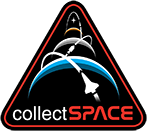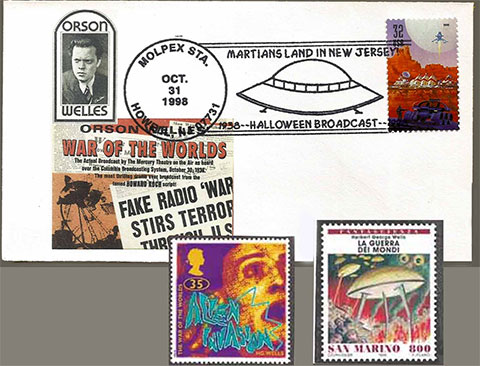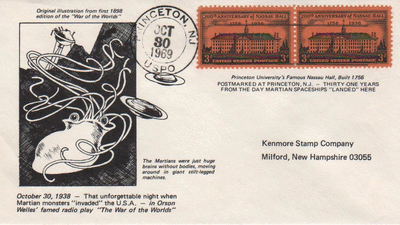Space Cover #502: Flash Gordon and "Mars Attacks The World"This entry is quite a bit different than our standard SCOTWs as I want to incorporate a story into showing a cover with a special meaning for me. Home televisions became available in 1947. Early in 1948 my dad bought an RCA Victor combination 8" diagonal screen TV with a built in AM and FM radio, because at that time TV was shown only in the evenings and Saturday and Sunday afternoons in Chicago, except for home baseball games by the Cubs and White Sox.
The first show for children that I recall is not mentioned on the internet, perhaps because it was only local. It was called "Time for Kids" and was the only program on TV on Saturday mornings. They served up many cartoons, but also some 15 chapter movie serials from the 1930s and 1940s. Serials were called cliff hangers as each one ended with some type of catastrophe to help persuade movie goers to return to the theater the following week to see the next chapter. For example if the hero or heroine fell over a cliff, the next episode would have them grabbing on to a tree root thus saving themselves.
My all time favorite series of serials were the three Flash Gordon releases which eventually led to my following the real space programs a decade after I first saw them. Flash became my boyhood hero.
The first serial was named, "Flash Gordon". It had also been edited and shortened into a feature length movie, renamed "Rocket Ship". It was to be released in early late November of 1938.
The second serial was created from a "Little Big Book" originally named Flash Gordon and the Witch Queen of Mongo. It had already been edited and shortened to a full length feature called "Flash Gordon's Trip to Mars" and was ready for release in November of 1938, to be shown as part of a double feature with the first movie, "Rocket Ship."
However, Orson Welles astounded the country with his Mercury Theatre on the air radio production of H.G. Wells' "The War of the Worlds" on Halloween in 1938. Universal then quickly had this second feature's title changed to "Mars Attacks the World," and a week after the Welles broadcast they opened it at The Squire Theater on Broadway as a major premiere event.
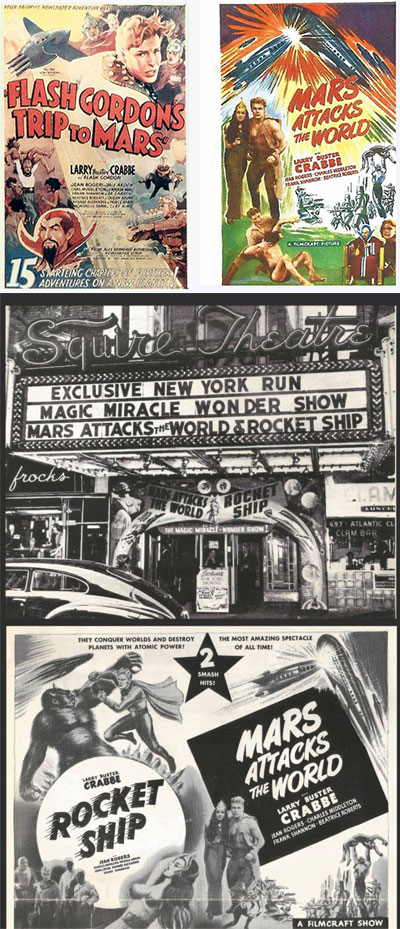
Flash Gordon became a comic strip that went on into the 1960s and on October 6, 1996 the United States Postal Service released a Flash Gordon stamp. I didn't have a computer back then but was able to transfer one of the comic strips to a no. 10 envelope using a heat transfer machine which is normally used for t-shirts and ball caps to cachet a First Day Cover.
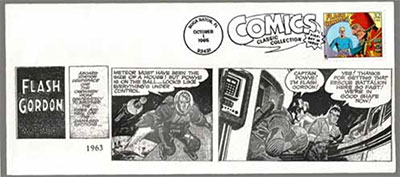
In 1978, I read in the Dallas Morning News that my hero, Buster Crabbe, aka Flash Gordon, along with Jean Rogers, aka Dale Arden, would be at a sci-fi event there and would be signing autographs at no charge. I wondered what I could get them to sign and then recalled the Pasadena, California slogan cancel for the first Viking Lander that read, "Langley Viking – NASA's First Lander On Mars." The tie-in jumped out at me.
When I met them I asked each to sign both their actual names and also their movie names of Flash Gordon and Dale Arden, which they did for me. Since the Flash Gordon film was the first film to show people landing on Mars, I showed my cover to Astronaut Hank Hartsfield, another Flash Gordon fan attending the SPACEPEX stamp show in Houston, telling him that I had the autographs of the first people on Mars. He looked at me and screwed up his face. When I showed him the cover, he broke into a wide smile and asked me for it. He took it immediately to show to his friend, Karl Henize saying to him, "Hey Karl, take a look at what Cartier has come up with this time!" Like Hartsfield, Karl smiled broadly.
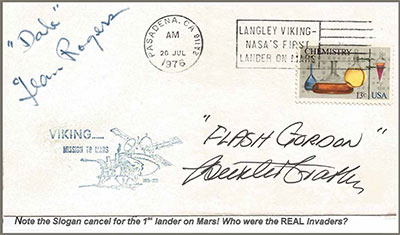
And that's the story that goes with this, one of my favorite, off-the-wall space covers!
